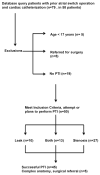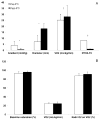Mustard baffle obstruction and leak - How successful are percutaneous interventions in adults?
- PMID: 29551876
- PMCID: PMC5856449
- DOI: 10.1016/j.ppedcard.2015.10.018
Mustard baffle obstruction and leak - How successful are percutaneous interventions in adults?
Abstract
Atrial switch operations for D-Transposition of the great arteries (D-TGA) were performed until the late 20th century. These patients have substantial rates of re-operation, particularly for baffle related complications. This study sought to analyze the efficacy of percutaneous transcatheter intervention (PTI) for baffle leak and/or stenosis in adult atrial switch patients. Adult patients with a prior atrial switch operation who underwent heart catheterization (2002-2014) at a tertiary adult congenital heart disease referral center were retrospectively analyzed. In 58 adults (30 ± 8 years, 75% men, 14% New York Heart Association (NYHA) functional class ≥2) who underwent 79 catheterizations, PTI was attempted in 50 (baffle leak (n = 10, 20%), stenosis (n = 27, 54%), or both (n = 13, 26%)). PTI was successful in 45 and 5 were referred for surgery due to complex anatomy. A total of 40 bare metal stents, 18 covered stents, 16 occlusion devices, 2 angioplasties, and 1 endovascular graft were deployed. In isolated stenosis, there was improvement in NYHA functional class after PTI (8 vs. 0 patients were NYHA FC > 2, p = 0.004), which was matched by improvement in maximal oxygen consumption on exercise testing (VO2) (25.1 ± 5.4 mL/kg/min vs. 27.9 ± 9 mL/kg/min, p = 0.03). There were no procedure-related deaths or emergent surgeries in this cohort. This single-center cohort is the largest reported series of adult atrial switch operation patients who have undergone PTI for baffle stenosis and/or leak. We demonstrate that PTI with an expert multi-disciplinary team is a safe and effective alternative to surgery in adult patients with an atrial switch operation.
Keywords: Baffle leak; Baffle stenosis; D-transposition of the great arteries; Mustard repair; Percutaneous intervention.
Figures




Similar articles
-
Intravascular and hybrid intraoperative stent placement for baffle obstruction in transposition of the great arteries after atrial switch.Catheter Cardiovasc Interv. 2017 Feb 1;89(2):306-314. doi: 10.1002/ccd.26783. Epub 2016 Oct 27. Catheter Cardiovasc Interv. 2017. PMID: 27785879
-
Lead Extraction With Baffle Stenting in Adults With Transposition of the Great Arteries.JACC Clin Electrophysiol. 2019 Jun;5(6):671-680. doi: 10.1016/j.jacep.2019.01.023. Epub 2019 Mar 27. JACC Clin Electrophysiol. 2019. PMID: 31221353
-
Advanced imaging improves detection of baffle leaks and stenoses after atrial switch compared with transthoracic echocardiography.Int J Cardiovasc Imaging. 2021 Sep;37(9):2767-2772. doi: 10.1007/s10554-021-02236-w. Epub 2021 Apr 17. Int J Cardiovasc Imaging. 2021. PMID: 33864562
-
[2D and Doppler echocardiography after atrial switch operation for transposition of great arteries; a review].Z Kardiol. 1996 Jan;85(1):35-44. Z Kardiol. 1996. PMID: 8717146 Review. German.
-
Atrial tachyarrhythmias after atrial switch operation for transposition of the great arteries: Treating old surgery with new catheters.Heart Rhythm. 2016 Aug;13(8):1731-8. doi: 10.1016/j.hrthm.2016.03.046. Epub 2016 Mar 24. Heart Rhythm. 2016. PMID: 27018378 Review.
Cited by
-
A Single-Center Review of Clinical Outcomes After Transcatheter Relief of Superior Vena Cava Stenosis in a Pediatric and Young Adult Population.J Soc Cardiovasc Angiogr Interv. 2024 Aug 3;3(10):102245. doi: 10.1016/j.jscai.2024.102245. eCollection 2024 Oct. J Soc Cardiovasc Angiogr Interv. 2024. PMID: 39525991 Free PMC article.
-
Holographic Techniques as a Novel Method for Intervention Planning: A Tertiary Centres Experience.Curr Health Sci J. 2023 Oct-Dec;49(4):584-593. doi: 10.12865/CHSJ.49.04.15. Epub 2023 Dec 29. Curr Health Sci J. 2023. PMID: 38559839 Free PMC article.
-
Complete Obstruction of Superior Mustard Baffle: Electrosurgical Transcatheter Recanalization-First-in-Human Case Report.J Soc Cardiovasc Angiogr Interv. 2024 Aug 22;3(10):102280. doi: 10.1016/j.jscai.2024.102280. eCollection 2024 Oct. J Soc Cardiovasc Angiogr Interv. 2024. PMID: 39525993 Free PMC article.
-
Management of Heart Failure in Adult Congenital Heart Disease.Heart Fail Clin. 2018 Oct;14(4):569-577. doi: 10.1016/j.hfc.2018.06.005. Epub 2018 Aug 20. Heart Fail Clin. 2018. PMID: 30266365 Free PMC article. Review.
-
Shortness of breath on a mustard patient: multidisciplinary approach improves outcomes.J Cardiothorac Surg. 2025 Aug 14;20(1):337. doi: 10.1186/s13019-025-03559-8. J Cardiothorac Surg. 2025. PMID: 40814046 Free PMC article.
References
-
- Mustard WT. Successful two-stage correction of transposition of the great vessels. Surgery. 1964;55:469–472. - PubMed
-
- Senning A. Surgical correction of transposition of the great vessels. Surgery. 1959;45:966–80. - PubMed
-
- Jatene AD, Fontes VF, Paulista PP, Neto CA, Sousa JE. Anatomic correction of transposition of the great vessels. J Thorac Cardiovasc Surg. 1976;72:364–70. - PubMed
-
- Ashraf MH, Cortroneo J, DiMarco D, Subramanian S. Fate of long-term survivors of mustard procedure (inflow repair) for simple and complex transposition of the great arteries. Ann Thorac Surg. 1986;42:385–9. - PubMed
Grants and funding
LinkOut - more resources
Full Text Sources
Other Literature Sources
